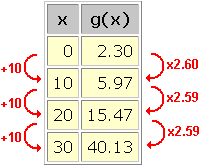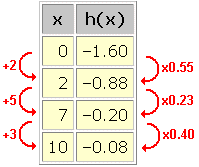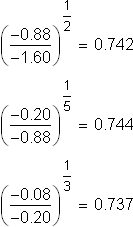Exponential Functions
Numeric Representation![]()
|
|
To recognize an exponential trend in a data set, we make use of the key algebraic property of exponential functions
![]()
We can read this equation this way: If the input x is increased by a constant interval (Dx), then the output f(x) will increase by a constant multiple (b Dx).
For data sets with constant intervals between inputs, this is an easy pattern to recognize:

In this data set, we see an approximately exponential trend with
We arrive at the following model for this data set:
This equation can be used to interpolate or extrapolate further data values.
Be careful: Because of the rapid rates of change in exponential functions, small variations in the model base b can produce sizable differences in predicted values.
What if a data set has not been recorded at equal intervals of the input? We can rewrite the key algebraic property this way:
This form of the equation can be read: Whatever the increase in input (Dx) between two data points,
We can recognize this pattern even in data sets without constant intervals between the inputs:

Nothing looks constant at first, but when we calculate the various

A constant base of approximately
There is another method for discovering exponential trends in data sets, called a semi-log transformation. To find out more, read the hint below.
Semi-log transformations of exponential data: ![]()
|
|
|
| Back to Contents | |